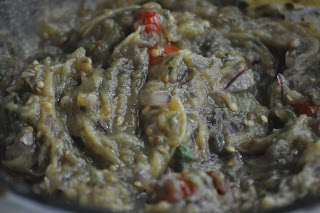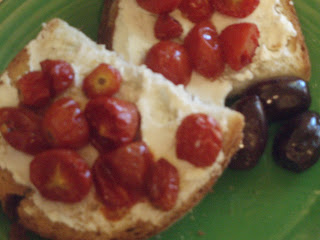I tackled this weeks French Fridays with Dorie selection--Cafe Salle Pleyel Hamburger (pg 240)--earlier in the week than I normally do. I wanted Matt to grill the burgers on the bbq, so it made more sense to do it on the weekend, since there's no telling what time he'll get home on any given workday.
This is unlike any burger I've ever had. First, you make an onion marmalade by simmering finely chopped red onion, coriander, butter, salt and pepper in water until it's a jammy consistency. I ate more of this with a spoon, hot off the stove, than I'd like to admit. It would be amazing on a hot dog. Just sayin'.
Grind up a seemingly random assortment of items (sun-dried tomatoes--I, again, used some of my slow-roasted tomatoes that are packed in oil in the fridge--capers, cornichons, fresh tarragon, and fresh parsley), then mix it in with the burger meat.
The marmalade goes on the roll, the burger goes on the marmalade, and slivers of parmesan cheese and thin-sliced dill pickles are supposed to go on top. I forgot to buy the pickles. Woops. A leftover chunk of blue cheese was winking at me from the fridge, so I forsook the parmesan and used blue cheese instead. It worked beautifully with all the other salty and sweet components.
I overdid the tarragon a bit. There was going to be too much left over that I had no plan for, so I threw in some extra, just to put it to use. It was still good, but the tarragon flavor was very prevalent and tipped the scales farther towards "sweet" than I think was intended.
 |
| I take terrible photos of meat. |
This is not the recipe I'd tap to satisfy a messy, juicy, ketchup-slathered burger craving, but it holds its own place as something else. It's almost more like a type of meatloaf on a bun than it is a burger.
Conclusion: Liked it, and it lends itself nicely to variations on the basic recipe. Love that onion marmalade. I could eat it on anything--sandwiches, salads. Yum.
Since I'm trying to backtrack and cover the FFwD selections that were cooked prior to my involvement with the group, I baked Marie-Helene's Apple Cake (pg 432) for dessert. Mine didn't come out looking like the picture, but it did come out tasting deeeeelicious. There was just enough of the vanilla and rum-spiked batter to cover the apples. I thought the cake would rise more in the oven, because in the book's picture, the cake covers the apples. Mine did not, but I think it looked quite adorable with the little browned chunks of apple sitting on top. The cake almost has a dense pudding or custard consistency, and is quite buttery and lovely. I could eat this every day. I won't though.
 |
| mmmm...cinnamon whipped cream. |
Conclusion: Liked it very much.
This meal prompted an interesting conversation between Matt and I. He said that he's such a fan of Dorie that he would never argue against me buying any of her cookbooks (he doesn't understand my fascination with buying cookbooks, and acts exasperated every time I bring in a new one). I wondered if she would ever publish another cooking book, since her background is in baking. Maybe she'd put everything she had into this one book and would return to baking now. (I sure hope not.) Matt suggested that maybe the reason we love her food and I produce such good results from Around My French Table has something to do with her coming from a baking background. He thinks I'm "an awesome baker" (awww), and said maybe there's a common thought process of people who are natural bakers vs. cooks that makes a cookbook-written-by-a-baker work differently. I'm not sure if that's true, but it's interesting to think about. My hypothesis is that, because Dorie is trained as a baker, the food in this book really is the food she serves at her table. It's
her food, with her own personal twists that are influenced and inspired by her friends and meals she has out, but were never tweaked according to the needs of a restaurant. In her intro to
Baking, she says that Julia Child told her "We make such a good team because we're really just a pair of home bakers." I think the success of her fans' relationship with
Around My French Table is the same. We make a good team because, with Dorie, via her book, we're just (several thousand) pairs of home cooks. What do you think? What makes this book different from others?







































